Notice: Use of this site constitutes your acceptance of these Terms of Use. Barataria Industries (a proud member of the of the Trans-Global
Enterprises family)
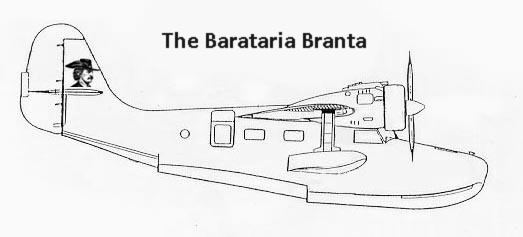 Because the performance of the float-equipped Beta Volantis was less than hoped for, the Barataria Aeronautical Corporation began development of a more seaworthy aircraft in 1937--a flying boat instead of a float plane. Earlier the Wotanberger Overseas
Airways Company [WOAC] had
permitted the Barataria design team an opportunity to
study its newly acquired pre-production Grumman Goose--which
later was to become known as "Cutter's Goose".* Inspired perhaps by
the Goose (and certainly motivated by the
possibility of future sales of a similar aircraft to
WOAC), Barataria's design team came up with the
plans for the Barataria Branta in late 1937.**
Although critics have claimed that
the Branta was merely a copy of the more
famous Goose, the contemporary line drawing
above of the Branta shows two of the many
obvious differences between the two aircraft. First,
the Branta's rear door is on the starboard
side of the aircraft and not the port side like the Goose.
Second, there is no retractable landing gear on the Branta.
Although this required use of a specially designed
detachable undercarriage to bring the Branta
onto land, it would not detract significantly from the
utility of the aircraft in the Grand
Duchy of Wotanberg's two
colonies, the Seiber
Islands and the Mustela
Islands. A photograph taken at the factory in 1938 confirms these differences between the well-known Goose and the Branta: 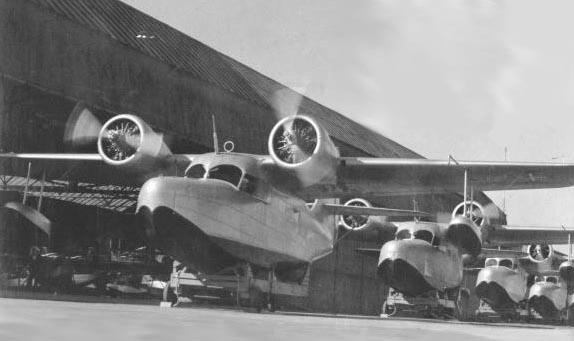 A total of six Brantas was sold to WOAC from 1938 to 1940 for use in the Grand Duchy of Wotanberg's two colonies. Here is a photograph of one of these Brantas with its WOAC crew before it was repainted in standard WOAC "livery": 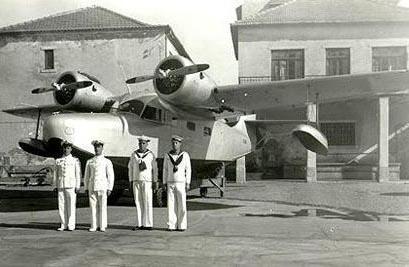 With the special consent of the U.S. government, two Brantas were sold to the Ichiban Shipping Company in late 1940.*** Here is a photograph of one of these aircraft upon its arrival at St. Hubert in the Seiber Islands. 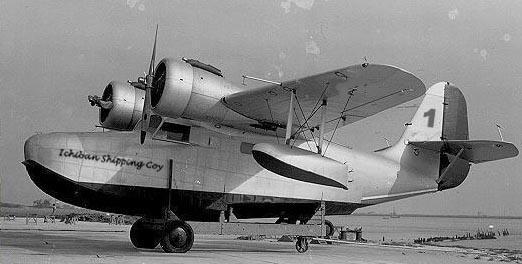 In early 1941, at the request of the
Grand Duchy
of Wotanberg, a special version of the
Branta was designed and built to assist the
crews of the High
Speed Fishing Boats [HSFB] which
were being built by Barataria for service in the
Seiber Islands.
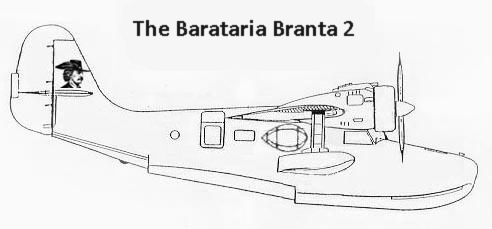 One of the most important features of the Branta 2 was the two plexiglass "bubbles" which enhanced surveillance of possible fishing areas to facilitate the efficient deployment of the HSFB. Other features included the ability to carry and deploy pyrotechnics to assist in the identification of targets for the crews of those boats. A pair of these special Brantas was sold to the Grand Duchy along with the HSFB. Fortuitously, after the attack on Pearl Harbor, these Brantas were easily converted into effective naval aircraft, and were credited with the destruction of at least 10 Japanese vessels. Unfortunately, neither of these Brantas survived the war. ________________________________________________ * On an
early test flight of the prototype, the Italian test
pilot invited his wife--Erica Giovani--along, in hopes
of curing her fear of flying. Seated in the
observation deck with its two bubble windows, Erica
sat twitching in fear until coaxed by husband to look
out the windows at the beautiful San Francisco
panorama. Opening her eyes for the first time during
the flight, Erica looked at the partially constructed
Golden Gate Bridge and exclaimed in her native * WOAC
had purchased the Goose to assess
its suitability for service in the Grand
Duchy of Wotanberg's two
colonies--the Seiber
Islands and the Mustela
Islands. Although WOAC appreciated
that the Goose was amphibious,
this was not seen as an important feature
and, by eliminating its landing gear, the range
and/or cargo capacity
could be increased. In addition, the Goose's
portside rear door did not conform with WOAC's
starboard side standard. *** These two Ichiban Brantas figured prominently not only in the defense of the Seiber Islands during World War Two but also in the economic recovery of both the Seiber Islands and the Marivellas after the war. After their "retirement" in 1950, they were donated to the Cutter Air Museum and are now on display at the Museum's St Hubert and Boragora facilities. |